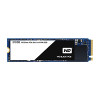Western Digital Black PCIe SSD M.2 Desktop Installation Guide - Page 8
Glossary, Basic Input/Output System (BIOS), M.2, NVM Express (NVMe)
 |
View all Western Digital Black PCIe SSD manuals
Add to My Manuals
Save this manual to your list of manuals |
Page 8 highlights
Glossary 2 Glossary For your benefit, some terms used in this Installation Guide are defined in this section. Basic Input/Output System (BIOS) The BIOS is built-in software that determines what a computer can do without accessing programs from a disk. On PCs, the BIOS contains all the code required to control the keyboard, display screen, disk drives, serial communications, and a number of miscellaneous functions at a basic level. Many modern PCs have a flash (see Flash Memory) BIOS, which means that the BIOS has been recorded on a flash memory chip, which can be updated if necessary. The PC BIOS is fairly standardized; so all PCs are similar at this level (although there are different BIOS versions). PC BIOSes that can handle Plug-and-Play (PnP) devices are known as PnP BIOSes, or PnP-aware BIOSes. These BIOSes are always implemented with flash memory rather than ROM. M.2 M.2 is a specification for internally mounted computer expansion cards and associated connectors. It replaces the mSATA standard, which uses the PCI Express Mini Card physical card layout and connectors. M.2 is an edge connector and slides into a slot that has the corresponding Key ID or notches. This is different than the typical SATA or even SATA Express connectors we see used on many storage devices. M.2's more flexible physical specification allows different module widths and lengths, and, paired with the availability of more advanced interfacing features, makes the M.2 more suitable than mSATA for solid-state storage applications in general and particularly for the use in small devices such as ultra-thin laptops or tablets. Computer bus interfaces provided through the M.2 connector are PCI Express 3.0 (up to four lanes), Serial ATA 3.0, and USB 3.0. The M.2 connector has different keying notches that denote various purposes and capabilities of M.2 hosts and modules, preventing plugging of M.2 modules into feature-incompatible host connectors. In addition to supporting legacy Advanced Host Controller Interface (AHCI) at the logical interface level, M.2 specification also supports NVM Express (NVMe) as the logical device interface for PCI Express SSDs implemented as M.2 storage devices. NVM Express (NVMe) NVMe or Non-Volatile Memory Host Controller Interface Specification (NVMHCI), is a technical standard that specifies the operation of host bus adapters accessing solid-state drives (SSDs) attached through the PCI Express (PCIe) bus. Basically, NVMe is a driver between a host and a device. As a logical device interface, NVM WD Black PCIe SSD 5 M.2 Desktop Installation Guide












